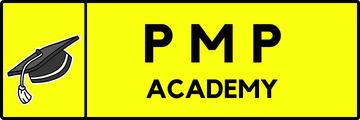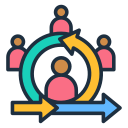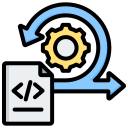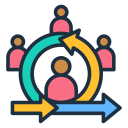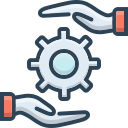Scrum Methodology For Project Management
Scrum Methodology For Project Management
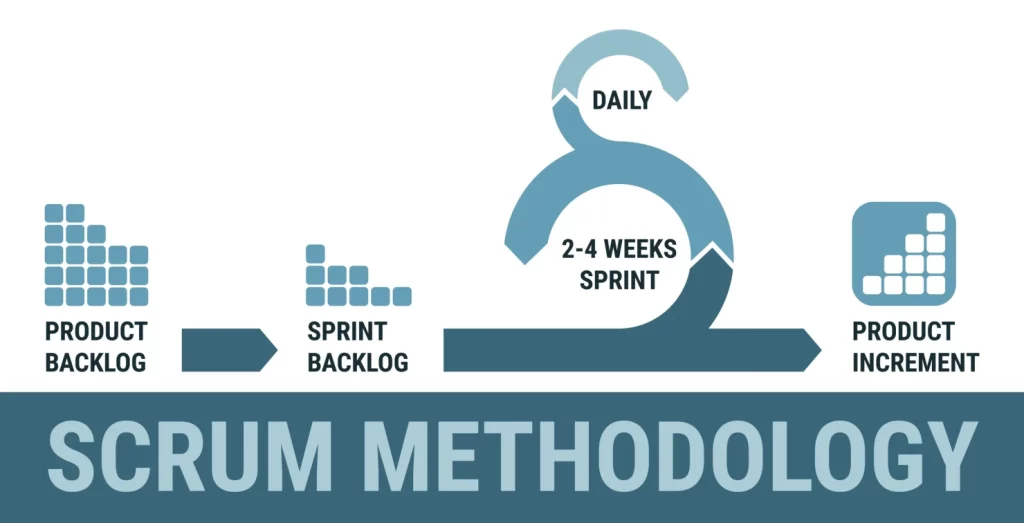
Contents
1. What is a Scrum master?
A Scrum Master plays a vital role in helping Agile development teams succeed by acting as a guide, coach, and supporter. Their main job is to uphold and promote the values, principles, and practices of the Scrum framework.
Firstly, a Scrum Master facilitates the Agile team’s activities. They lead the team through events like Sprint Planning, Daily Stand-ups, Sprint Reviews, and Retrospectives, making sure everything runs smoothly. They encourage communication and collaboration among team members, ensuring everyone contributes to the team’s goals.
Beyond facilitating events, a Scrum Master also coaches the team in adopting Scrum practices and principles. They help team members understand their roles and responsibilities within the framework. This coaching extends beyond the team to include stakeholders and other parts of the organization, promoting an Agile mindset and aligning with Agile values.
Another crucial part of the Scrum Master’s role is removing obstacles that hinder the team’s progress. Whether it’s solving technical issues, resolving conflicts within the team, or dealing with organizational challenges, the Scrum Master shields the team from distractions and helps them stay focused on their work.
2. What Is the Scrum Methodology?
Scrum isn’t just a way of working; it’s a philosophy that changes how teams handle complex projects, especially in software development. At its core, Scrum is an Agile framework that offers a structured yet flexible approach to managing projects, helping teams deal with uncertainty and deliver value step by step.
Key to Scrum is its focus on iterative development. Instead of trying to plan out every detail upfront, Scrum divides the project into smaller parts called “Sprints,” usually lasting one to four weeks. Each Sprint produces a piece of the product that can potentially be delivered to users, allowing teams to deliver value continuously.
Scrum also promotes regular review and adaptation. Throughout the project, teams check their progress often and adjust their plans as needed. This continuous feedback loop lets teams respond quickly to changes in requirements, market conditions, or technical issues.
It promotes ongoing improvement, where teams can test new ideas, learn from mistakes, and improve their work over time.
Another core principle of Scrum is its focus on delivering high-quality products efficiently. By breaking the project into smaller parts, teams can catch and fix problems early in the process. This not only reduces the risk of costly errors but also ensures that the product meets users’ evolving needs.
3. History of the Scrum Methodology?
The Scrum methodology began in the early 1990s when Jeff Sutherland and Ken Schwaber, both software developers, introduced it to manage complex projects better. They wanted to address the challenges and inefficiencies of traditional project management, especially in software development.
Scrum was inspired by ideas from empirical process control theory and Japanese manufacturing practices. Sutherland and Schwaber saw the need for a more flexible approach to project management that could handle the uncertainties and rapid changes in software development.
The term “Scrum” comes from rugby, where players tightly gather to restart play. This reflects the collaborative and iterative nature of the Scrum framework, where teams work closely together to achieve goals.
Initially, Scrum was mainly used in software development. Teams liked its approach of breaking projects into smaller parts and delivering value in iterations. This allowed them to adapt quickly to changes and produce better products.
Over time, Scrum expanded beyond software. Its principles proved useful in industries like manufacturing, healthcare, marketing, and education. Organizations of all kinds began using Scrum to boost productivity, encourage innovation, and respond faster to market needs.
4. The Scrum Framework
The Scrum framework offers a structured way to manage projects, focusing on teamwork, openness, and flexibility. It includes specific roles, events, and items that guide teams through the project cycle.
At its core, Scrum defines three main roles: the Product Owner, the Scrum Master, and the Development Team. The Product Owner represents stakeholders and ensures the product meets their needs. They prioritize tasks, manage the Product Backlog (a list of all tasks), and guide the team to deliver what’s required.
The Scrum Master supports the team as a leader and guide. They help remove obstacles that could slow progress, coach the team on Agile methods, and ensure Scrum events (like meetings) run smoothly. They also encourage the team to constantly improve.
The Development Team creates the product in each Sprint (a short project phase). They’re self-organizing and have all the skills needed to complete the work. They work closely with the Product Owner to understand requirements and deliver value to customers.
In addition to roles, Scrum defines key events:
- Sprint Planning : At the start of each Sprint, the team plans what they'll do and sets goals.
- Daily Stand-ups : Short meetings each day to update progress and plan tasks.
- Sprint Reviews : Meetings at the end of each Sprint to show what's done and get feedback.
- Sprint Retrospectives : Meetings after each Sprint to review what went well and what could be better.
Scrum also uses artifacts (documents or items):
- Product Backlog : A list of all tasks to do, prioritized by importance.
- Sprint Backlog : Part of the Product Backlog for the current Sprint.
- Increment : All completed tasks at the end of a Sprint, ready to use.
5. Roles and Responsibilities of a Scrum master
A Scrum Master’s role in the Scrum framework is diverse, requiring leadership, facilitation, coaching, and servant leadership skills. Their main job is to ensure the team understands and effectively uses the Scrum process, creating an environment where productivity, collaboration, and improvement thrive.
As a facilitator, the Scrum Master organizes Scrum events like Sprint Planning, Daily Stand-ups, Sprint Reviews, and Retrospectives. They guide these meetings to ensure they’re productive and encourage teamwork.
Additionally, the Scrum Master acts as a coach. They help team members grasp Agile principles and practices, guiding them through challenges and helping them make smart decisions. They also mentor team members, supporting their growth and encouraging them to take responsibility for their work.
A crucial part of the Scrum Master’s role is removing obstacles that could slow down the team. This might involve solving technical problems, resolving conflicts, or dealing with organizational issues. By clearing these hurdles, the Scrum Master keeps the team focused on achieving their goals.
6. The Product Owner Role
The Product Owner speaks for the stakeholders, sets product requirements, and aims to maximize the product’s value. They decide what tasks are most important, make choices for stakeholders, and ensure the team and business goals are on the same page.
7. The Scrum Master Role
The Scrum Master helps the Scrum team by guiding and coaching them. They make sure everyone understands and follows the Scrum process, removes any obstacles that get in the team’s way, encourages teamwork, and supports ongoing improvements.
8. The Scrum Development Team
The Scrum Development Team is made up of professionals who create a part of the product that could be released at the end of each Sprint. They work together, have a variety of skills, and are responsible for delivering high-quality work.
9. When Should You Use the Scrum Methodology?
Deciding to use Scrum depends on factors like the project’s complexity, uncertainty, team’s Agile knowledge, and organizational culture. Scrum is best suited for:
1. Complex and Adaptive Projects : Scrum works well for projects with lots of changes and uncertainties. Teams can adjust plans as they go, delivering value step by step instead of planning everything upfront.
2. Cross-Functional Teams : Scrum is great for teams with diverse skills. By bringing together people with different expertise, Scrum boosts collaboration, creativity, and problem-solving, leading to high-quality products.
3. Projects with Stakeholder Involvement : Scrum involves stakeholders throughout the project. The Product Owner works closely with them to gather needs, give feedback, and prioritize tasks, ensuring the product meets user expectations.
4. Projects with Changing Requirements : Scrum handles projects where needs often change. Teams can adjust quickly, making sure the product stays valuable in fast-moving markets.
5. Continuous Improvement : Scrum encourages teams to always get better. Regular meetings let teams review progress and find ways to improve, learning from mistakes and trying new ideas.:
6. Organizational Readiness : Scrum needs support from all levels of the organization. Leaders should be ready to empower teams, adapt to change, and create a culture of teamwork and openness. Teams should get proper training to use Scrum well.
10. What Are the Artifacts of the Scrum Methodology?
In Scrum, artifacts are tools that help teams see progress, inspect work, and collaborate better. They show the work and how it’s going throughout the project. Here are the main artifacts:
1. Product Backlog : This is a list of all tasks for the project, prioritized by importance. It includes everything the team needs to do, like features, fixes, and improvements. The Product Owner manages it, keeping it updated and aligned with the project’s goals.
2. Sprint Backlog : This is part of the Product Backlog for the current Sprint. It lists tasks chosen for that Sprint, decided in the Sprint Planning meeting. It changes as the team works, helping them stay focused on what’s most important for that Sprint.
3. Increment : This is all the tasks completed by the end of a Sprint. It’s a part of the product that’s ready to use or show to stakeholders. The Increment shows progress, and teams review it at the end of each Sprint to get feedback and make adjustments.
These artifacts help teams work together well, make smart choices, and adapt to changes. They show how the project is going and make sure teams deliver value efficiently. Using these artifacts, Scrum teams improve their work over time and create better products.
11. What Are the Scrum Events in the Scrum Process?
In Scrum, events are scheduled meetings that help teams work better together throughout a project. These events allow teams to plan, review, and improve their work. Here are the main events:
1. Sprint Planning : At the start of each Sprint, the Scrum Team (Product Owner, Scrum Master, and Development Team) meets to set goals and pick tasks from the Product Backlog. They create a Sprint Backlog, listing what they’ll finish by the Sprint’s end.
2. Daily Stand-up : Every day in a Sprint, there’s a quick meeting (Daily Scrum). Each team member says what they did yesterday, what they’ll do today, and if there are any problems. It’s for planning, not just updates.
3. Sprint Review : At the end of each Sprint, the team shows what they’ve finished to stakeholders. The Product Owner explains the work, and stakeholders give feedback. This helps keep everyone on the same page about what’s done and what might need changing.
4. Sprint Retrospective : Also at the end of each Sprint, the team looks back on how things went. They talk about what worked well, what didn’t, and what they can do better next time. It’s about learning and getting better at how they work together.
These events help teams collaborate, fix problems, and keep improving their work over time.
12. Essential Scrum Tools for Your Next Sprint
There are several helpful tools for managing Scrum projects:
- Jira: Developed by Atlassian, Jira is widely used in large enterprises and IT companies for Agile project management. It’s robust and supports complex project needs.
- Trello: Popular across teams of all sizes, Trello is known for its simple interface and task organization features. It’s flexible and widely used in industries like software development and marketing.
- Zoho Sprints: This cloud-based tool is designed specifically for Scrum. It helps with planning, task assignments, and progress tracking, making it easy to collaborate and manage projects effectively.
- Active Collab: Ideal for creative professionals, Active Collab offers comprehensive project management tools. It includes features for budget management, time tracking, and task visualization in calendars, boards, or lists.
- Scrumwise: Simplifies task management with features like checklists and progress tracking. It’s great for keeping teams focused on project goals and ensuring visibility into project status.
13. What Are Scrum Values in the Scrum Methodology?
Scrum values are the core principles that guide how Scrum teams work together. They create a foundation of trust, teamwork, and constant improvement.
1. Commitment: Every team member is deeply dedicated to achieving the project’s goals. They commit to their roles, support each other, and strive for excellence. This commitment builds trust and keeps everyone focused on the same objectives.
2. Focus: In Scrum, staying focused on the tasks at hand is crucial. Team members concentrate on the work planned for each Sprint, avoiding distractions. This focus boosts productivity and ensures that work is completed efficiently and meets the Sprint goals.
3. Openness: Transparency and honesty are key. Team members openly share information, ideas, and concerns. This openness builds trust and helps teams handle challenges together. It fosters a culture where everyone feels heard and accountable.
4. Respect: Respect is fundamental in Scrum teams. Team members value each other’s opinions, backgrounds, and contributions. This inclusive environment encourages collaboration and empowers everyone to contribute their best.
5. Courage: Scrum requires Courage. Team members are encouraged to take on tough challenges, suggest new ideas, and confront difficult truths. They speak up and learn from mistakes, seeing setbacks as opportunities to grow and innovate.
14. What techniques can Scrum masters use?
Scrum Masters employ various methods to help Agile teams effectively use the Scrum framework. These techniques promote teamwork, continuous improvement, and remove obstacles to progress. Here are key techniques:
1. Servant Leadership: Scrum Masters focus on serving the team rather than directing them. They prioritize the team’s needs, advocate for resources, and create a supportive environment where team members feel motivated and empowered.
2. Coaching and Mentoring: Scrum Masters guide team members on Agile principles and practices. They help clarify roles, offer advice, and support individual growth through coaching sessions and continuous feedback.
3. Facilitation: Scrum Masters ensure that Scrum events like Sprint Planning and Reviews run smoothly. They create a safe space where everyone can contribute ideas, fostering collaboration and keeping the team aligned with their goals.
4. Conflict Resolution: Addressing conflicts constructively is crucial. Scrum Masters encourage open communication, active listening, and empathy to help resolve conflicts within the team, ensuring everyone stays focused on their tasks.
5. Visual Management: Using tools like task boards and charts, Scrum Masters make work progress visible to the team. This transparency helps team members track their tasks, make informed decisions, and collaborate effectively.
6. Continuous Improvement: Scrum Masters promote a culture of learning and growth. They organize sessions like Sprint Retrospectives to reflect on past performance, identify areas for improvement, and implement changes to enhance team productivity.
15. What Are the Main Roles In a Scrum Team?
In a Scrum team, there are three main roles: the Product Owner, the Scrum Master, and the development Team. Each role is essential for the project’s success, bringing unique skills, perspectives, and responsibilities.
The Product Owner represents stakeholders’ interests and focuses on maximizing the product’s value. They act as the voice of the customer, advocating for their needs and priorities. The Product Owner collaborates closely with stakeholders to gather requirements, define the product vision, and prioritize the backlog based on business value and user feedback. They ensure the team understands the project’s goals, clarifying features and functionality for delivery.
The Scrum Master serves as a servant-leader, facilitating the Scrum process and removing obstacles to progress. They coach the team on Agile principles and practices, ensuring effective Scrum events and fostering a collaborative, continuous improvement culture.
The Scrum Master shields the team from external distractions, empowering them to self-organize and make autonomous decisions. They advocate for the team’s needs, nurturing a positive work environment.
The Development Team is responsible for delivering a potentially shippable product increment by the end of each Sprint. It’s a self-organizing, cross-functional group with the skills and expertise needed to develop the product.
The team works closely with the Product Owner to understand requirements, planning and executing work collaboratively. They take collective ownership of the product, continuously improving their processes and practices.
Each role within the Scrum team has distinct responsibilities but collaborates closely to achieve shared objectives.
The Product Owner provides direction and prioritization, the Scrum Master facilitates the process and removes impediments, and the Development Team delivers the product.
Together, they form a cohesive unit dedicated to delivering value to stakeholders and adapting iteratively to changing requirements.
16. Advantages of the Scrum Methodology
The Scrum methodology offers numerous advantages for teams and organizations aiming to deliver projects efficiently, adapt to change effectively, and maximize stakeholder value. From its iterative approach to its emphasis on collaboration and continuous improvement, Scrum provides a framework that empowers teams to navigate complexity and deliver high-quality products. Here are some key advantages of the Scrum methodology:
1. Iterative Development: Scrum embraces an iterative approach, dividing work into manageable increments known as Sprints. Each Sprint yields a potentially shippable product increment, enabling teams to deliver value to stakeholders early and frequently. By focusing on incremental functionality, Scrum allows teams to swiftly adapt to evolving requirements and feedback, minimizing risks and ensuring ongoing relevance and value for users.
2. Flexibility and Adaptability: Designed for flexibility, Scrum enables teams to respond swiftly to shifting priorities, requirements, and market conditions. Its iterative nature facilitates the incorporation of feedback, ensuring that the product aligns closely with user needs over time. This adaptability proves invaluable in dynamic environments, where rapid adjustments can determine project success.
3. Collaboration and Transparency: Scrum fosters a culture of collaboration and transparency among team members and stakeholders. Through regular Scrum events like Sprint Planning, Daily Stand-ups, Sprint Reviews, and Retrospectives, teams maintain open communication, align on objectives, and pinpoint areas for improvement. Artifacts such as the Product Backlog and Sprint Backlog enhance transparency, keeping stakeholders informed and engaged throughout the project lifecycle.
4. Empowered Teams: Scrum empowers teams to self-organize and make autonomous decisions, fostering ownership and accountability. Clear roles and responsibilities enable team members to collaborate effectively, innovate, and resolve challenges independently. This autonomy boosts motivation, engagement, and productivity within the team, driving results while minimizing external interference.
5. Continuous Improvement: At its core, Scrum promotes continuous improvement through iterative feedback loops and reflection. Sprint Retrospectives and other feedback mechanisms allow teams to assess processes, identify opportunities for enhancement, and implement changes iteratively. This culture of continuous learning enables teams to refine practices, deliver higher-quality outputs, and innovate consistently over time.
6. Predictable Delivery: Despite embracing change, Scrum provides mechanisms for predictability in project delivery. By breaking down work into manageable increments and setting clear Sprint goals, Scrum enables teams to forecast timelines accurately and manage stakeholder expectations effectively. This predictability is crucial for resource allocation, budget management, and meeting project deadlines with confidence.
17. Disadvantages of the Scrum Methodology
While the Scrum methodology offers significant advantages, it also presents challenges and disadvantages that teams and organizations should consider:
1. Complexity: Scrum is a comprehensive framework requiring a deep understanding of its principles, roles, events, and artifacts for effective implementation. The learning curve can be steep for teams new to Agile practices, potentially leading to confusion, frustration, and resistance to change. Managing complexity becomes more challenging with larger or more intricate projects, complicating the scaling of Agile practices across organizations.
2. Dependency on Team Dynamics: Scrum relies heavily on the collaboration and self-organization of cross-functional teams. While this fosters creativity, innovation, and team ownership, it necessitates strong trust, communication, and collaboration among team members. Dysfunctional team dynamics, conflicts, or personality clashes can impede progress and impact project outcomes adversely.
3. Scope Creep: A common challenge in Scrum is scope creep, where project requirements expand beyond initial boundaries. Without robust mechanisms for scope management, teams may struggle to prioritize tasks effectively, leading to a growing backlog and potential delays, budget overruns, and stakeholder dissatisfaction due to unmet expectations.
4. Overhead of Scrum Events: Scrum events like Sprint Planning, Daily Stand-ups, Sprint Reviews, and Retrospectives offer valuable collaboration, communication, and reflection opportunities. However, they also demand significant time and effort from team members, potentially diverting focus from actual product development. Poorly managed event frequency or duration can burden teams, diminishing productivity and morale.
5. Risk of Burnout: The iterative and fast-paced nature of Scrum can contribute to high-stress levels and burnout among team members. Pressure to deliver within short cycles and constantly adapt to changes in requirements may strain mental and emotional well-being. Maintaining adequate support systems and promoting work-life balance are crucial to mitigating burnout risks and sustaining team engagement and productivity.
18. Glossary of Scrum Methodology Terms
The Scrum methodology is accompanied by specific terms and concepts that help teams and stakeholders understand and communicate effectively within the framework. Here’s a glossary of crucial Scrum terms:
1. Scrum : Scrum is an Agile framework for managing complex projects, known for its iterative and incremental approach to product development.
2. Sprint : A Sprint is a time-boxed iteration in Scrum, typically lasting 1-4 weeks, focused on creating a potentially shippable product increment.
3. Product Backlog: The Product Backlog is a prioritized list of all project work items, managed and maintained by the Product Owner.
4. Sprint Backlog: The Sprint Backlog is a subset of the Product Backlog containing tasks committed to during the current Sprint, owned by the Development Team.
5. Product Owner: The Product Owner represents stakeholders, prioritizes the Product Backlog, and maximizes the product’s value through effective management.
6. Scrum Master: The Scrum Master facilitates and coaches the Scrum Team, ensuring the Scrum process is understood and applied effectively.
7. Development Team: The Development Team is a self-organizing, cross-functional group responsible for delivering a potentially shippable product increment each Sprint.
8. Sprint Planning: Sprint Planning is a collaborative meeting at the start of each Sprint where the Scrum Team defines goals and selects work items.
9. Daily Stand-up: The Daily Stand-up, or Daily Scrum, is a brief daily meeting during the Sprint where team members synchronize activities and address obstacles.
10. Sprint Retrospective: The Sprint Retrospective occurs at the Sprint’s end, enabling the team to reflect on processes and identify opportunities for improvement.
11. Increment: The Increment is the sum of completed Product Backlog items at the Sprint’s conclusion, representing a potentially shippable product.
12. Burndown Chart: A Burndown Chart visually tracks remaining work in the Sprint, depicting progress towards completing the Sprint Backlog.
13. Impediment: An Impediment is any obstacle hindering the Scrum Team’s progress, managed by the Scrum Master to facilitate smoother workflows.
14. Definition of Done: The Definition of Done defines criteria necessary for a Product Backlog item to be considered complete and ready for release.
15. Velocity: Velocity measures the amount of work the Development Team completes in a Sprint, aiding in forecasting future progress and planning subsequent Sprints.
19. How Project Manager Enables the Scrum Process
ProjectManager is a robust project management software designed to enhance the efficiency and effectiveness of Scrum teams. Here’s how ProjectManager supports and facilitates the Scrum process:
1. Task Management: ProjectManager enables teams to create, assign, and track tasks efficiently. It simplifies management of both the Product Backlog and Sprint Backlog by allowing teams to break down work into smaller tasks, prioritize them based on business value, and assign them to team members. Features like task dependencies, deadlines, and progress tracking help teams stay organized and focused on delivering value in each Sprint.
2. Backlog Management: Teams can effectively manage Product and Sprint backlogs using ProjectManager. They can create, prioritize, and manage user stories, epics, and tasks in the Product Backlog. During Sprint Planning, teams can easily move selected items from the Product Backlog to the Sprint Backlog, ensuring clear planning and task allocation for each Sprint.
3. Collaboration Tools: Collaboration is facilitated through features like comments, file attachments, and real-time updates in ProjectManager. Integration with communication tools like Slack and Microsoft Teams enhances team connectivity and engagement throughout the project lifecycle, supporting seamless communication and information sharing.
4. Reporting and Analytics: ProjectManager offers robust reporting and analytics capabilities, empowering teams to track progress, identify trends, and make informed decisions. Customizable reports and dashboards visualize key metrics such as burndown charts, velocity, and sprint progress, providing real-time insights into project status and performance for proactive decision-making and continuous improvement.
5. Resource Management: The software includes features for effective resource management, enabling teams to allocate resources optimally based on availability and skills. Task assignment, resource tracking, and capacity management functionalities help teams maximize productivity and ensure projects are delivered on time and within budget.
6. Scrum Framework Support: ProjectManager supports essential Scrum practices and ceremonies. It facilitates scheduling and execution of Sprint Planning, Daily Stand-ups, Sprint Reviews, and Retrospectives. Customizable workflows and task statuses allow teams to tailor the tool to fit their specific Scrum practices and preferences, ensuring adherence to the Scrum framework effectively.
20. The Scrum Master vs the Project Manager
Scrum Master:
The Scrum Master plays a vital role within the Scrum framework and is responsible for ensuring that the Scrum process is understood and followed by the Scrum Team. Here are some critical aspects of the Scrum Master role:
1. Servant-Leader: Acting as a servant-leader, the Scrum Master prioritizes the needs of the Scrum Team, empowering them to self-organize and make autonomous decisions. Rather than directing the team, they facilitate an environment conducive to success.
2. Process Facilitator: The Scrum Master oversees Scrum events such as Sprint Planning, Daily Stand-ups, Sprint Reviews, and Retrospectives, ensuring these meetings are productive and efficient. They remove obstacles that hinder progress, enabling the team to focus on delivering value during each Sprint.
3. Coach and Mentor: Serving as a coach and mentor, the Scrum Master guides the Scrum Team in understanding and applying Agile principles effectively. They support the team in refining their roles, events, and artifacts, fostering continuous improvement in their practices.
4. Stakeholder Liaison: Acting as a bridge between the Scrum Team and stakeholders, the Scrum Master facilitates clear communication and alignment. They advocate for stakeholder interests within the team and ensure that the product meets user needs, managing expectations throughout the development process.
5. Continuous Improvement: Promoting a culture of continuous improvement, the Scrum Master facilitates Sprint Retrospectives and other feedback mechanisms. They encourage the team to reflect on their processes, experiment with new ideas, and implement changes that enhance team performance and product quality over time.
Project Manager :
The Project Manager oversees projects using traditional methodologies like Waterfall or Prince2. Here are the key responsibilities associated with the Project Manager role:
1. Overall Responsibility: The Project Manager holds ultimate responsibility for the project’s success, encompassing scope, schedule, budget, and resource management. They maintain a comprehensive view of the project, ensuring alignment across all aspects to achieve project objectives.
2. Planning and Execution: Responsible for project planning and execution, the Project Manager defines project goals, develops project plans, and allocates resources effectively. They monitor progress against the plan and take corrective actions to keep the project on course.
3. Risk Management: Identifying and managing risks throughout the project lifecycle, the Project Manager proactively mitigates potential threats and capitalizes on opportunities. They anticipate issues, devising contingency plans to minimize disruptions to project progress.
4. Stakeholder Management: Engaging with stakeholders throughout the project lifecycle, the Project Manager manages expectations and communicates project status, risks, and issues regularly. They build trust and confidence among stakeholders, ensuring transparency and alignment with project goals.
5. Documentation and Reporting: Maintaining meticulous project documentation, the Project Manager generates regular reports on project status, progress, and performance. They provide stakeholders with accurate and up-to-date information, enabling informed decision-making and facilitating effective communication channels.
21. Scrum vs. Agile: Differences and similarities
Agile:
Agile is founded on a set of principles and values articulated in the Agile Manifesto, which underscores flexibility, collaboration, and customer satisfaction. Here are key aspects of Agile:
1. Values and Principles: Agile adheres to the Agile Manifesto, which centers on four core values and twelve principles emphasizing individuals and interactions, working products, customer collaboration, and responsiveness to change over rigid planning.
2. Flexibility and Adaptability: Agile promotes adaptability to changing requirements and priorities, empowering teams to deliver incremental value and swiftly respond to customer feedback and market dynamics.
3. Customer Focus: Agile places a strong emphasis on customer collaboration and satisfaction, striving to deliver functional products that meet customer needs and provide value early and consistently.
4. Iterative and Incremental Delivery: Agile encourages iterative and incremental delivery of products and features. This approach allows teams to break down work into smaller, manageable segments and deliver value progressively throughout the project lifecycle.
5. Continuous Improvement: Agile fosters a culture of continuous improvement, encouraging teams to reflect on their processes, identify areas for enhancement, and implement changes to boost performance and efficiency over time.
Scrum
Scrum is a specific Agile framework designed for managing complex projects, characterized by its iterative and incremental approach to product development. Here are key aspects of Scrum:
1. Framework: Scrum operates as a framework within the Agile methodology, offering defined roles, events, artifacts, and guidelines that govern how work is planned, executed, and reviewed within a project.
2. Roles: Scrum delineates three primary roles: the Product Owner, the Scrum Master, and the Development Team. Each role carries specific responsibilities crucial to the project’s overall success within the Scrum framework.
3. Events: Scrum incorporates essential events such as Sprint Planning, Daily Stand-ups, Sprint Reviews, and Retrospectives. These events facilitate collaboration, inspection, and adaptation throughout the project lifecycle.
4. Artifacts: Scrum defines three primary artifacts: the Product Backlog, the Sprint Backlog, and the Increment. These artifacts capture project requirements, track work progress, and represent the project’s evolution, ensuring transparency and alignment among the Scrum Team and stakeholders.
5. Time-boxing: Scrum employs time-boxing to structure work into fixed-length iterations known as Sprints, typically lasting 1-4 weeks. This time-boxing establishes a rhythm for the team, enabling them to consistently plan, execute, and review work.
Differences:
- Scope: Agile encompasses principles and values, while Scrum is a specific framework within the Agile domain.
- Structure: Agile offers flexibility with a variety of frameworks and practices, whereas Scrum provides a more structured approach with defined roles, events, and artifacts.
- Focus: Agile centers on values and principles guiding project management, while Scrum focuses on specific methodologies and practices for project execution.
Similarities:
- Iterative and Incremental Delivery: Both Agile and Scrum advocate for iterative and incremental delivery of products and features, enabling teams to respond promptly to change and deliver value consistently.
- Customer Collaboration: Both Agile and Scrum prioritize customer collaboration and satisfaction, aiming to deliver products that meet customer needs and provide tangible value.
22. Wrike streamlines Scrum efforts
1. Task Management : Wrike offers robust task management capabilities designed to streamline Scrum team workflows. Teams can effortlessly create, prioritize, and track tasks within Wrike. They can break down user stories and epics into smaller, actionable tasks, assign them to team members, set due dates, and manage dependencies. With these features, Wrike ensures clear task ownership and keeps projects on schedule and focused.
2. Backlog Management : Wrike empowers teams to manage both Product and Sprint Backlogs effectively. Teams can utilize custom dashboards and boards to visualize and prioritize user stories and tasks. Real-time progress tracking allows teams to adapt quickly to changing requirements and maintain focus on delivering value during each Sprint.
3. Collaboration Tools : Collaboration is central to Scrum success, and Wrike provides a suite of collaboration tools. Features like comments, @mentions, and file attachments enable seamless teamwork and information sharing. Integration with communication tools such as Slack and Microsoft Teams ensures continuous connectivity and engagement across the project lifecycle.
4. Customizable Workflows : Wrike enables teams to tailor workflows to align with specific Scrum practices and preferences. Custom statuses, workflows, and fields track work items through each project stage, ensuring clarity and smooth progress. This customization capability helps teams optimize their processes within Wrike for maximum efficiency and alignment.
5. Reporting and Analytics : Wrike’s robust reporting and analytics capabilities empower teams to make informed, data-driven decisions. Custom reports and dashboards visualize key metrics like burndown charts, velocity, and Sprint progress. Real-time insights into project status enable teams to identify trends, monitor performance, and continuously improve delivery efficiency.
6. Integration with Scrum Practices : Wrike seamlessly integrates with Scrum practices and ceremonies, supporting Sprint Planning, Daily Stand-ups, Sprint Reviews, and Retrospectives. Teams can schedule and conduct Scrum events directly within Wrike, ensuring adherence to the Scrum framework and maximizing efficiency in delivering stakeholder value.
FAQ's
1. What is Scrum methodology?
Scrum is an Agile framework used in project management. It is characterized by its iterative and incremental approach to product development. It emphasizes collaboration, adaptability, and delivering value to stakeholders in short, time-boxed iterations called Sprints.
2. What are the main events in Scrum methodology?
The critical roles in Scrum methodology are the Product Owner, Scrum Master, and Development Team. The Product Owner represents stakeholders' interests and maximizes the product's value. The Scrum Master is a facilitator and coach for the Scrum Team, ensuring that the Scrum process is understood and implemented effectively. The Development Team is a self-organizing and cross-functional group responsible for delivering a potentially shippable product increment at the end of each Sprint.
3. What are the critical roles in Scrum methodology?
The main events in Scrum methodology are Sprint Planning, Daily Stand-up, Sprint Review, and Sprint Retrospective. Sprint Planning is a collaborative meeting at the beginning of each Sprint where the Scrum Team defines the Sprint Goal and selects the work to be done. Daily Stand-up is a short, time-boxed meeting that occurs every day during the Sprint, where team members synchronize their activities and identify any obstacles to progress. Sprint Review is held at the end of each Sprint and is an opportunity for the Scrum Team to demonstrate the Increment of work completed and gather feedback from stakeholders. Sprint Retrospective is held at the end of each Sprint and provides the Scrum Team with an opportunity to reflect on their processes and identify areas for improvement.
4. What is the Product Backlog in Scrum methodology?
A Sprint in Scrum methodology typically lasts 1-4 weeks, with two weeks being the most common duration. The Scrum Team determines the length of the Sprint based on factors such as project complexity, team capacity, and stakeholder expectations.
7. What are the advantages of using Scrum methodology?
Some advantages of using Scrum methodology include increased flexibility and adaptability, faster time to market, improved collaboration and communication, higher quality products, and greater stakeholder satisfaction.
8. What are the advantages of using Scrum methodology?
Some advantages of using Scrum methodology include increased flexibility and adaptability, faster time to market, improved collaboration and communication, higher quality products, and greater stakeholder satisfaction.
9. What are the disadvantages of using Scrum methodology?
Some disadvantages of using Scrum methodology include its complexity and learning curve, dependency on team dynamics, risk of scope creep, overhead of Scrum events, limited predictability, and potential for burnout among team members.
10. How can I get started with Scrum methodology?
To start with Scrum methodology, you can learn about its principles, roles, events, and artifacts. Consider attending Scrum training or workshops, reading books and articles about Scrum, and seeking guidance from experienced practitioners. You can also start implementing Scrum practices gradually within your team and iteratively improve over time.
11. Is Scrum methodology suitable for all types of projects?
While Scrum methodology is well-suited for many projects, it may not suit all projects or organizations, particularly those with unique requirements or constraints. It is essential to assess your project's specific needs and context and determine whether Scrum is the right approach.
